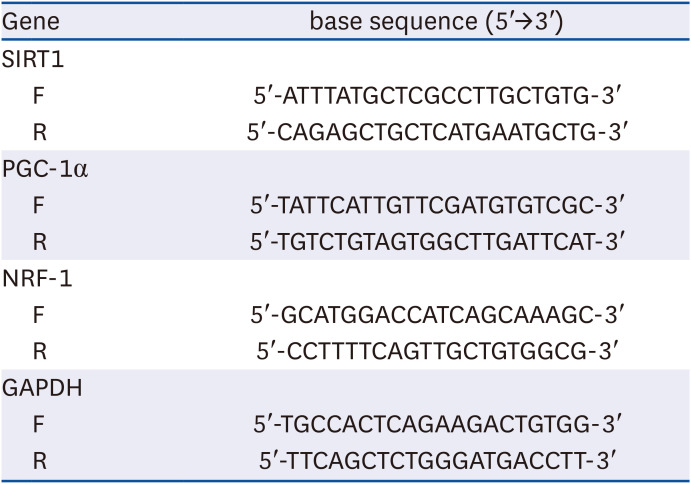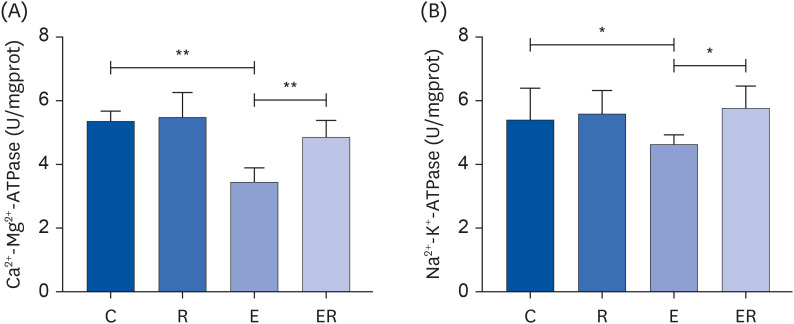1. Li M, Ning B, Wang T. The mechanism and prevention of mitochondrial injury after exercise. J Physiol Biochem. 2021; 77:215–225. PMID:
33650090.

2. Ismaeel A, Holmes M, Papoutsi E, Panton L, Koutakis P. Resistance training, antioxidant status, and antioxidant supplementation. Int J Sport Nutr Exerc Metab. 2019; 29:539–547. PMID:
30859847.

3. Corr LD, Field A, Pufal D, Clifford T, Harper LD, Naughton RJ. The effects of cocoa flavanols on indices of muscle recovery and exercise performance: a narrative review. BMC Sports Sci Med Rehabil. 2021; 13:90. PMID:
34391456.

4. Solheim SA, Nordsborg NB, Ritz C, Berget J, Kristensen AH, Mørkeberg J. Use of nutritional supplements by Danish elite athletes and fitness customers. Scand J Med Sci Sports. 2017; 27:801–808. PMID:
27264018.

5. Galiniak S, Aebisher D, Bartusik-Aebisher D. Health benefits of resveratrol administration. Acta Biochim Pol. 2019; 66:13–21. PMID:
30816367.

6. Hou CY, Tain YL, Yu HR, Huang LT. The effects of resveratrol in the treatment of metabolic syndrome. Int J Mol Sci. 2019; 20:535. PMID:
30695995.

7. Ma N, Tao H, Du H, Zhao L, Hu Q, Xiao H. Antifatigue effect of functional cookies fortified with mushroom powder (Tricholoma matsutake) in mice. J Food Sci. 2020; 85:4389–4395. PMID:
33159467.

8. Fernandes T, Hashimoto NY, Magalhães FC, Fernandes FB, Casarini DE, Carmona AK, Krieger JE, Phillips MI, Oliveira EM. Aerobic exercise training-induced left ventricular hypertrophy involves regulatory MicroRNAs, decreased angiotensin-converting enzyme-angiotensin ii, and synergistic regulation of angiotensin-converting enzyme 2-angiotensin (1-7). Hypertension. 2011; 58:182–189. PMID:
21709209.

9. Alway SE, McCrory JL, Kearcher K, Vickers A, Frear B, Gilleland DL, Bonner DE, Thomas JM, Donley DA, Lively MW, et al. Resveratrol enhances exercise-induced cellular and functional adaptations of skeletal muscle in older men and women. J Gerontol A Biol Sci Med Sci. 2017; 72:1595–1606. PMID:
28505227.

10. Polley KR, Jenkins N, O’Connor P, McCully K. Influence of exercise training with resveratrol supplementation on skeletal muscle mitochondrial capacity. Appl Physiol Nutr Metab. 2016; 41:26–32. PMID:
26638911.

11. Gocmez SS, Gacar N, Utkan T, Gacar G, Scarpace PJ, Tumer N. Protective effects of resveratrol on aging-induced cognitive impairment in rats. Neurobiol Learn Mem. 2016; 131:131–136. PMID:
27040098.

12. Wang X, Qu Y, Zhang Y, Li S, Sun Y, Chen Z, Teng L, Wang D. Antifatigue potential activity of
Sarcodon imbricatus in acute excise-treated and chronic fatigue syndrome in mice via regulation of Nrf2-mediated oxidative stress. Oxid Med Cell Longev. 2018; 2018:9140896. PMID:
30050662.
13. Wang L, Zhang HL, Lu R, Zhou YJ, Ma R, Lv JQ, Li XL, Chen LJ, Yao Z. The decapeptide CMS001 enhances swimming endurance in mice. Peptides. 2008; 29:1176–1182. PMID:
18440669.

14. Osman WN, Mohamed S. Standardized
Morinda citrifolia L. and
Morinda elliptica L. leaf extracts alleviated fatigue by improving glycogen storage and lipid/carbohydrate metabolism. Phytother Res. 2018; 32:2078–2085. PMID:
29993148.

15. Zhang G, Mao J, Liang F, Chen J, Zhao C, Yin S, Wang L, Tang Z, Chen S. Modulated expression and enzymatic activities of Darkbarbel catfish,
Pelteobagrus vachelli for oxidative stress induced by acute hypoxia and reoxygenation. Chemosphere. 2016; 151:271–279. PMID:
26945243.

16. Pirkmajer S, Petrič M, Chibalin AV. The role of AMPK in regulation of Na
+,K
+-ATPase in skeletal muscle: does the gauge always plug the sink? J Muscle Res Cell Motil. 2021; 42:77–97. PMID:
33398789.

17. Wyckelsma VL, Perry BD, Bangsbo J, McKenna MJ. Inactivity and exercise training differentially regulate abundance of Na
+-K
+-ATPase in human skeletal muscle. J Appl Physiol. 2019; 127:905–920. PMID:
31369327.

18. Fernández ÁF, Liu Y, Ginet V, Shi M, Nah J, Zou Z, Zhou A, Posner BA, Xiao G, Tanguy M, et al. Interaction between the autophagy protein Beclin 1 and Na
+, K
+-ATPase during starvation, exercise, and ischemia. JCI Insight. 2020; 5:e133282. PMID:
31941841.

19. Rasheed MR, Tarjan G. Succinate dehydrogenase complex: an updated review. Arch Pathol Lab Med. 2018; 142:1564–1570. PMID:
30289269.

20. Jacques M, Kuang J, Bishop DJ, Yan X, Alvarez-Romero J, Munson F, Garnham A, Papadimitriou I, Voisin S, Eynon N. Mitochondrial respiration variability and simulations in human skeletal muscle: the Gene SMART study. FASEB J. 2020; 34:2978–2986. PMID:
31919888.

21. Alhindi Y, Vaanholt LM, Al-Tarrah M, Gray SR, Speakman JR, Hambly C, Alanazi BS, Gabriel BM, Lionikas A, Ratkevicius A. Low citrate synthase activity is associated with glucose intolerance and lipotoxicity. J Nutr Metab. 2019; 2019:8594825. PMID:
30944739.

22. Reid SN, Park JH, Kim Y, Kwak YS, Jeon BH.
In vitro and
in vivo effects of fermented oyster-derived lactate on exercise endurance indicators in mice. Int J Environ Res Public Health. 2020; 17:8811. PMID:
33260934.

23. Sun J, Zhang C, Kim M, Su Y, Qin L, Dong J, Zhou Y, Ding S. Early potential effects of resveratrol supplementation on skeletal muscle adaptation involved in exercise-induced weight loss in obese mice. BMB Rep. 2018; 51:200–205. PMID:
29519293.

24. Vincenzi KL, Maia TP, Delmônego L, Lima AB, Pscheidt LC, Delwing-Dal Magro D, Delwing-de Lima D. Effects of resveratrol on alterations in cerebrum energy metabolism caused by metabolites accumulated in type I citrullinemia in rats. Naunyn Schmiedebergs Arch Pharmacol. 2021; 394:873–884. PMID:
33205249.

25. Villareal MO, Matsukawa T, Isoda H. L-citrulline supplementation-increased skeletal muscle PGC-1α expression is associated with exercise performance and increased skeletal muscle weight. Mol Nutr Food Res. 2018; 62:e1701043. PMID:
29797700.

26. Vargas-Ortiz K, Pérez-Vázquez V, Macías-Cervantes MH. Exercise and sirtuins: a way to mitochondrial health in skeletal muscle. Int J Mol Sci. 2019; 20:2717. PMID:
31163574.

27. Ma S, Feng J, Zhang R, Chen J, Han D, Li X, Yang B, Li X, Fan M, Li C, et al. SIRT1 activation by resveratrol alleviates cardiac dysfunction via mitochondrial regulation in diabetic cardiomyopathy mice. Oxid Med Cell Longev. 2017; 2017:4602715. PMID:
28883902.

28. Huang WC, Hsu YJ, Wei L, Chen YJ, Huang CC. Association of physical performance and biochemical profile of mice with intrinsic endurance swimming. Int J Med Sci. 2016; 13:892–901. PMID:
27994494.

29. Menzies KJ, Singh K, Saleem A, Hood DA. Sirtuin 1-mediated effects of exercise and resveratrol on mitochondrial biogenesis. J Biol Chem. 2013; 288:6968–6979. PMID:
23329826.

30. Chuang YC, Chen SD, Hsu CY, Chen SF, Chen NC, Jou SB. Resveratrol promotes mitochondrial biogenesis and protects against seizure-induced neuronal cell damage in the hippocampus following status epilepticus by activation of the PGC-1α signaling pathway. Int J Mol Sci. 2019; 20:1422–1476. PMID:
30901819.

31. Wang D, Sun H, Song G, Yang Y, Zou X, Han P, Li S. Resveratrol improves muscle atrophy by modulating mitochondrial quality control in STZ-induced diabetic mice. Mol Nutr Food Res. 2018; 62:e1700941. PMID:
29578301.

32. Muhammad MH, Allam MM. Resveratrol and/or exercise training counteract aging-associated decline of physical endurance in aged mice; targeting mitochondrial biogenesis and function. J Physiol Sci. 2018; 68:681–688. PMID:
29230719.









 PDF
PDF Citation
Citation Print
Print




 XML Download
XML Download